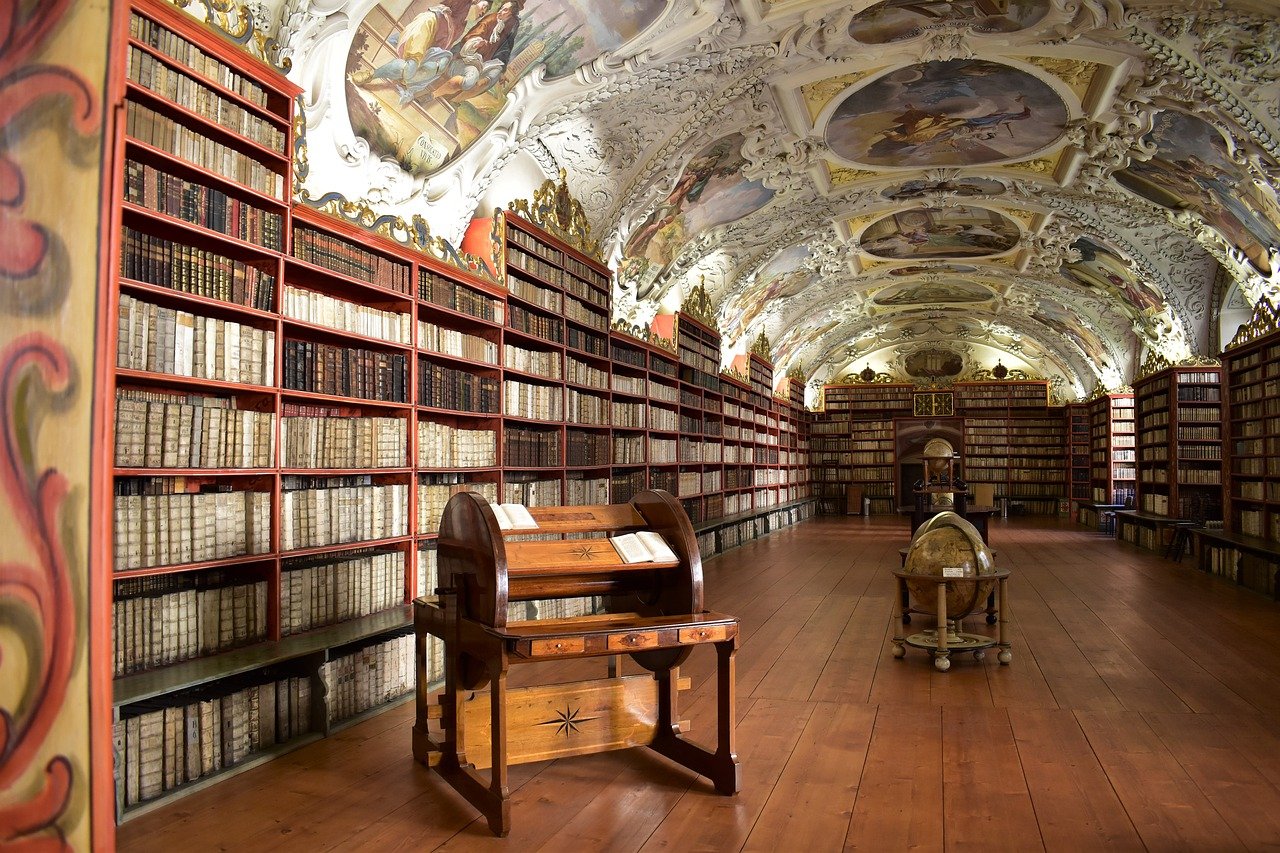On the Murmuring of Books and the Abyss

“Outside theology and fantastic literature, few can doubt that the main features of our universe are its dearth of meaning and lack of discernible purpose,” writes Alberto Manguel at the beginning of The Library at Night. “And yet, with bewildering optimism, we continue to assemble whatever scraps of information we can gather in scrolls and books and computer chips, on shelf after library shelf, whether material, visual or otherwise, pathetically intent on lending the world a semblance of sense and order, while knowing perfectly well that, however much we’d like to believe the contrary, our pursuits are sadly doomed to failure.” I disagree that there is a dearth of meaning in the universe—human meanings and purposes may be small and hardly central, but they are not insignificant—but I share Manguel’s sense of the pathos of the human attempt to assemble and order all that we have learned about the universe. In these attempts, we are subject both to the limits of our understanding and to mere entropy. How easily a book is misplaced, lost, torn, or burned. And how easy it is for misunderstandings to occur, or for errors to slip in or to be deliberately added to the record by bad actors.
The role of the librarian as protector of human understanding against entropy and error seems especially urgent to me now, when it often feels that we are on the precipice of yet another dark age. I am planning to go back to school this fall (whatever that might look like in this terrible year) to become a librarian, and though from my job in an archive as an undergraduate I have some experience of the not-particularly-dramatic realities of library work, I lately have been treating my imagination to tales about books and libraries in the previous so-called dark age, such as Umberto Eco’s 1980 bestselling novel The Name of the Rose.
The medieval library in Eco’s novel represents an inversion of my usual thinking about the architecture of a library, protective role of the librarian, and nature of books themselves. For example, patrons of the Manuscripts and Archives Department at Sterling Library, where I worked as an undergraduate, were not allowed beyond the Reading Room; only librarians and library employees (like lucky me) could go down into the underground rooms where the materials were stored. Such precautions were intended to keep the manuscripts out of the hands of vandals and thieves. Similar precautions are taken in the fourteenth-century library in The Name of the Rose, which only the librarian is permitted to enter. Additional safeguards there are more extreme: the rooms of the library are organized in a disorienting labyrinth, herbs are left burning there at night to induce hallucinations in intruders, and a hidden room, called the finis Africae, is walled off from all others. These safeguards, however—especially the hidden room—are designed not to protect the library from any outside menace, but to keep what is believed to be a menace locked within the library. As the abbot of the Benedictine monastery that maintains the library explains, “Not all truths are for all ears, not all falsehoods can be recognized as such by a pious soul; and the monks, finally, are in the scriptorium to carry out a precise task, which requires them to read certain volumes and not others, and not to pursue every foolish curiosity that seizes them, whether through weakness of intellect or through pride or through diabolical prompting.”
The perceived menace does get out, of course, and is associated with a series of deaths that occur over the seven days of the narrative. “I prepare to leave on this parchment my testimony as to the wondrous and terrible events that I happened to observe in my youth, now repeating all that I saw and heard, without venturing to seek a design,” begins the narrator, Adso of Melk, an aged Benedictine monk, in telling about the events he witnessed in late 1327, when he was a young novice. At the time, he accompanied a Franciscan monk, Brother William of Baskerville, on a journey through northern Italy to the unnamed Benedictine monastery. There, Brother William is to represent the thinking of the theologians of the Holy Roman Emperor in a meeting between representatives of the pope (then based in Avignon) and leaders of the Franciscan order.
Upon Adso and William’s arrival, the abbot, Abo, asks William to investigate the recent death of Adelmo, a gifted illuminator who fell from a window in the Aedificium—the tower that contains the kitchen and refectory, the scriptorium, and, on its uppermost floor, the library. William is an excellent choice for the task. Not only was he once an Inquisitor for the church, a student of philosopher Roger Bacon, and friend of theologian William of Occam (whom Eco considered making his investigator before, he writes, “I gave up that idea, because I do not find the Venerable Inceptor very attractive as a human being”), but he is also especially observant and skilled at interpreting evidence, as he demonstrates by inferring (as Sherlock Holmes might) from a collection of the slightest clues that the monks and servants who first greet him and Adso just outside the monastery are searching for a lost horse: Brunellus, the abbot’s favorite.
Over the following days, as William’s investigation proceeds, several other monks die, apparently from murder: Venantius of Salvamec, a translator, is found in a jar of pig’s blood; Berengar, the assistant librarian, is found seemingly drowned in a bath; Severinus, the herbalist, is found in his laboratory with his head bashed in; and Malachi, the librarian, collapses and dies in the church early one morning, after matins. All are connected in some way either to the library or to a mysterious manuscript in Greek (which few can read) that has gone missing. In the end, William follows a trail of false clues to the culprit and the cursed book, whose identity and contents he has been able to infer, in part, from other books.
As Adso realizes, a library is not just a building, nor can it keep books entirely sealed off from the rest of the world—a library is also a network of books speaking of books, “as if they spoke among themselves.” Later, he wonders if books speak only of books, and if “the final something, the true one—does that never exist?” “Perhaps it does,” William replies; he believes in possibilities and makes no rash commitments to knowledge. As he says, he finds “the most joyful delight in unraveling a nice, complicated knot. And it must also be because, at a time when as a philosopher I doubt the world has an order, I am consoled to discover, if not an order, at least a series of connections in small areas of the world’s affairs.”
There are echoes of Manguel’s view of the universe in this explanation, but without Manguel’s sense that the effort to give order to the world is futile. William, after all, is not a librarian, attempting to assemble and give order to all—or even a significant part of—human knowledge. He is content simply to find “at least a series of connections in small areas of the world’s affairs.” His opponent, on the other hand, turns out to be the man who, though lacking the title of librarian, has actually been running the monastery library from the shadows, locking away the books he deems dangerous and striving (indirectly) to poison anyone who would try to read the book he deems most dangerous of all. This most dangerous book is no grimoire, but a book of philosophy; unlike William, the monastery’s secret librarian does not wish to entertain or even admit any speculation whatsoever about possibilities. In William’s view, the evil of his opponent is grounded in his certainty: “the Devil is the arrogance of the spirit, faith without smile, truth that is never seized by doubt. The Devil is grim because he knows where he is going, and, in moving, he always returns whence he came.”
As for Adso, after witnessing murder, lust, heresy, the terrors of the Inquisition, and an all-consuming conflagration, all inextricably associated with the library, he neither embraces certainty nor adopts William’s curiosity. To him, a library in which books speak of books is a disturbance; it is “the place of a long-centuries-old murmuring, an imperceptible dialogue between one parchment and another, a living thing, a receptacle of powers not to be ruled by a human mind, a treasure of secrets emanated by many minds, surviving the death of those who had produced them or had been their conveyors.” At one point, he wonders if it were better for books to be preserved, but not read. He ultimately turns away from “intelligence that wants to know and will that wants to do” in favor of an unquestioning devotion to the Rule of St. Benedict, and by the conclusion of the book, his faith appears to be a form of nihilism. “Gott ist ein lauter Nichts, ihn rührt kein Nun noch Hier,” he writes— God is nothing, nothing touches him now or here. “I shall sink into the divine shadow, in a dumb silence and an ineffable union, and in this sinking all equality and all inequality shall be lost, and in that abyss my spirit will lose itself, and will not know the equal or the unequal, or anything else: and all differences will be forgotten.”
In Adso’s abyss, again, there is an apparent affirmation of Manguel’s view that “the main features of our universe are its dearth of meaning and lack of discernible purpose.” Adso, however, seems to prefer meaninglessness and the abyss above attempts to pursue meaning. And yet in his adulthood he assembles “a kind of lesser library, a symbol of the greater, vanished one,” and at the end of his life becomes the author of a book, thus, in the face of the abyss, contributing to the murmuring of books across the centuries. Where does the murmuring come from, except from the abyss? Aren’t we, and our meaning-making, part of the apparently meaningless universe?
My favorite portrayal of the relationship between meaning-making (through the making of art, however, rather than philosophy) and the abyss is the 2009 animated film The Secret of Kells, a gorgeously rendered tale about the making of an illuminated manuscript of the four Gospels that was likely completed in early ninth-century Ireland: the Book of Kells. The protagonist of the film, a boy named Brendan, lives in the Abbey of Kells under the watch of the abbot, his uncle, who is obsessed with building a wall that he expects will protect the abbey from Viking raids. After Vikings destroy his monastery on the island of Iona, master illuminator Brother Aidan takes refuge at Kells, bringing with him a beautiful book; afterward, despite his uncle’s demands that he devote himself to the wall, Brendan yearns only to help Aidan complete the book.
Whereas in The Name of the Rose, books are solely human concerns, in The Secret of Kells the making of the book is deeply connected to the natural world: specifically the forest just outside the walls of the abbey. Even a shape-shifting fairy, Aisling, aids Brendan, helping him get gall nuts for making ink, and helping him to escape when his uncle, who had forbidden him to work on the book, locks him in his room. So that he can make the book’s magnificent Chi Rho page, Brendan goes into the abyss—the forest cave of Crom Cruach, a pre-Christian Irish deity—to get a magnifying lens called the Eye of Colm Cille.
I am reminded of William’s spectacles, which, if they cannot always help him find the truth, at least help him “look more closely.” Perhaps, as William suggests, there may be no end to looking; in the meantime, we have the murmuring of books, including such treasures as the Book of Kells. I, too, have been disturbed by this murmuring. My earliest experiences of the library, in fact, were of a pleasure so intense that I often felt nausea. Its riches were infinite, impossible ever to comprehend entirely, which both delighted and terrified me.


